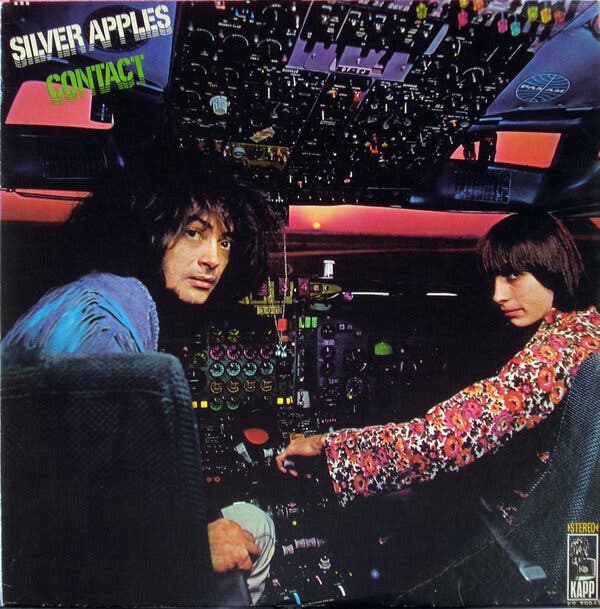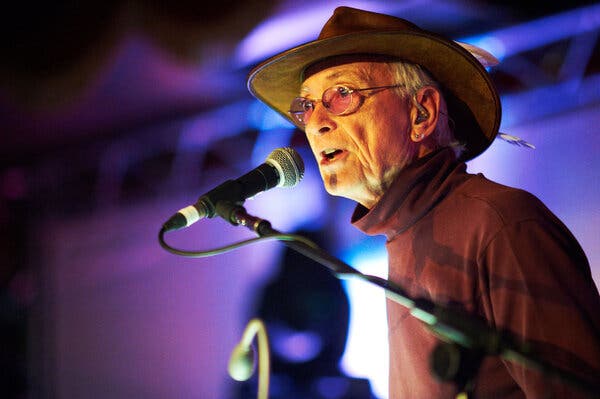Simeon Coxe, a songwriter, singer and inventor whose psychedelic-era band Silver Apples was one of the first to put a synthesizer at the center of its music, died on Tuesday at his home in Fairhope, Ala. He was 82.
The cause was pulmonary fibrosis, his management said.
Silver Apples was a two-man band: Dan Taylor on drums and Mr. Coxe, billing himself simply as Simeon, playing an unwieldy proto-synthesizer that he had built himself, and that his label named the Simeon. With its debut album, called simply “Silver Apples,” in 1968, the duo presaged the minimalist repetition, drones, dissonances and unearthly electronic timbres of krautrock bands like Can, Suicide’s electro-punk, and countless synth-pop and electronic dance music efforts to come.
“It never sounded weird to me,” Mr. Coxe told The Guardian in 2019. “We weren’t intending to be futuristic. We were just kids playing and making pop music.”
Silver Apples released only two albums in the late 1960s. After they were rereleased and rediscovered in the 1990s, Mr. Coxe returned to recording and touring worldwide with various lineups of Silver Apples, including a late-1990s reunion with Mr. Taylor. The original Simeon synthesizer was eventually replaced by a smaller, less balky digital successor.
Simeon Oliver Coxe III was born in Knoxville, Tenn., on June 4, 1938. His father, Simeon Oliver Coxe Jr., was a civil engineer and his mother, Mary Caddel Moses, was a kindergarten teacher.
Mr. Coxe grew up in New Orleans, hearing musicians like Fats Domino in local clubs and playing trumpet in his high school band. He moved to New York City as a teenager and tried to establish a career as a visual artist in his 20s; he also learned the banjo and sang with a bluegrass band, Random Concept.
In 1967 he became the singer for the Overland Stage Electric Band, which appeared often at the Cafe Wha? in Greenwich Village. He found a military-surplus oscillator from the 1940s and began playing its swoopy notes at gigs with the band. Except for Mr. Taylor, the other band members hated it and quit.
Mr. Coxe and Mr. Taylor carried on as a duo under the name Silver Apples, taken from a William Butler Yeats poem, and started to build songs around Mr. Taylor’s repeating drum patterns and Mr. Coxe’s oscillator drones and gentle vocals.
“This is not something that we were doing just for a lark,” Mr. Coxe said in an interview for the New Jersey free-form radio station WFMU in 2016. “We were quite serious about what we were doing. We really felt that the oscillator was as valid an instrument as a violin or a trombone or anything else.”

He added more and more oscillators to the Simeon, which grew to include 16 oscillators along with foot pedals, telegraph keys, push buttons, wah-wah pedals, Echoplex looping devices and a speaker. Playing it required hands, feet and elbows. “Sometimes I would make two or three oscillators drone right through the whole thing and play some rhythm with my elbow on the telegraph keys and then play lead oscillator during breaks,” Mr. Coxe explained to Clash magazine in 2010.
The vintage oscillators in the Simeon were susceptible to power fluctuations and other factors, often veering out of tune. In an interview for Red Bull Music Academy in 2012, Mr. Coxe joked that the Simeon sounded like “the mating call between a jackhammer and a Veg-O-Matic.”
In the late 1960s, Silver Apples performed around New York at venues including Max’s Kansas City and the Fillmore East; Andy Warhol made a portrait of Mr. Coxe. Jimi Hendrix, with whom Mr. Taylor had occasionally played drums, encouraged Silver Apples and later jammed with them.
Kapp Records signed the duo and released “Silver Apples” in 1968. Mr. Coxe’s opening lyrics were “Oscillations, oscillations, electronic evocations of sound’s reality.”
Mayor John V. Lindsay endorsed the band and invited Silver Apples to play in New York City parks. On July 20, 1969, Silver Apples performed at the Sheep Meadow in Central Park for thousands gathered to watch the Apollo 11 moon landing.
But the second Silver Apples album, “Contact,” released in 1969, ended the group’s early career. Silver Apples had gotten permission to use a Pan Am airplane cockpit for the album cover, featuring the airline’s logo, but the back cover showed a crashed Pan Am plane. Pan Am sued both the band and Kapp Records, contributing to the label’s eventual shuttering.
Silver Apples recorded a third album, “The Garden,” but it went unreleased until 1998. Under financial and legal stress, the duo broke up.
Mr. Coxe moved to Mobile, Ala., where he had relatives. In the 1970s and ’80s he drove an ice cream truck and worked as a television cameraman and an on-air news reporter in Alabama, Virginia and Maryland.
Meanwhile, Silver Apples’ music was circulating among electronics-loving bands like Stereolab and Portishead. A bootleg German reissue of the band’s two albums and a 1996 Silver Apples tribute album, “Electronic Evocations,” garnered so much attention that Mr. Coxe decided to restart the group.
Mr. Coxe and new backup musicians, Michael Lerner on drums and Xian Hawkins on keyboards, released new albums as Silver Apples: a collection of songs, “Beacon,” in 1997, and a 43-minute electronic jam, “Decatur,” in 1998. Silver Apples also collaborated with Spectrum, a group led by Pete Kember of Spacemen 3, on the 1998 album “A Lake of Teardrops.”
The original configuration of Silver Apples was reunited after Mr. Taylor heard the band’s music on WFMU and phoned the station, which put him back in touch with Mr. Coxe. The duo performed together in 1997. But while they were on tour their van crashed, and Mr. Coxe suffered a broken neck.
Mr. Taylor died in 2005.
In 2007 Mr. Coxe resumed touring internationally as Silver Apples, performing solo with samples of Mr. Taylor’s drum parts. He made two albums in a duo called Amphibian Lark, released in 2013 and 2016, with his longtime companion, Lydia Winn LeVert, on vocals, keyboards and bass. She survives him, as does his brother, David S. Coxe.
Mr. Coxe made a final Silver Apples album, “Clinging to a Dream,” in 2016, largely on his own, with contributions from Ms. LeVert and Mr. Hawkins.
“You can’t imagine what it was like in the beginning, when everybody hated my music,” Mr. Coxe said in the WFMU interview that year. “And now, with people apparently liking it all around the world, it’s a huge rush for me.”






